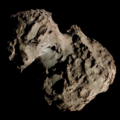61P/Shajn–Schaldach
 Comet Shajn–Schaldach photographed from the Zwicky Transient Facility on 19 October 2022. | |
| Discovery | |
|---|---|
| Discovered by | Pelageja F. Shajn Robert D. Schaldach |
| Discovery site | Simeiz Observatory, USSR Lowell Observatory, USA |
| Discovery date | 18–20 September 1949 |
| Orbital characteristics[2][3] | |
| Epoch | 2014-Dec-9 |
| Aphelion | 5.2458 AU |
| Perihelion | 2.1080 AU |
| Semi-major axis | 3.5769 AU |
| Eccentricity | 0.4267 |
| Orbital period | 7.49 yr |
| Inclination | 6.0097° |
| Last perihelion | 23 October 2022 |
| Next perihelion | 25 November 2029[1] |
| Physical characteristics[4][5] | |
Mean radius | 0.61±0.03 km |
| 4.9 hours | |
61P/Shajn–Schaldach is a periodic comet in the Solar System with a current orbital period of 7.49 years.[6]
Observational history
[edit]It was discovered on 18 September 1949 on a photographic plate by Pelageja F. Shajn at the Simeiz Observatory, Crimea, part of the Crimean Astrophysical Observatory. It was also discovered independently two days later by Robert D. Schaldach at the Lowell Observatory in Arizona, US, also on a photographic plate. Shajn then found evidence of the comet on earlier photographs taken on August 28 and September 4.
The first computations of the comet's orbit gave a perihelion date of between December 1949 and October 1950 with a periodicity of 7.76 years. After taking into account perturbations due a close approach to Jupiter the next perihelion was calculated to be on 15 March 1957 but in that year it was never found. It was also not discovered on its next predicted appearance in 1964. The most likely explanation for the two failures was the comet's faintness.
It was, however, re-located on 29 September 1971 by Charles T. Kowal of the Department of Astrophysics, California Institute of Technology, US, using the 122 cm Palomar Schmidt telescope, who estimated its brightness at a faint magnitude of 16. Other astronomers confirmed the sighting.
The comet was successfully observed on its subsequent returns in 1979, 1986, 1993, 2001 and 2008.
Physical characteristics
[edit]Based on observations by the Hubble Space Telescope the nucleus of the comet has an effective radius of 0.61±0.03 km.[4]
See also
[edit]References
[edit]- ^ "Horizons Batch for 61P/Shajn–Schaldach (90000662) on 2029-Nov-25" (Perihelion occurs when rdot flips from negative to positive). JPL Horizons. Retrieved 2023-07-06. (Soln.date: 2023-May-04)
- ^ "61P/Shajn–Schaldach – JPL Small-Body Database Lookup". ssd.jpl.nasa.gov. Jet Propulsion Laboratory. Retrieved 22 July 2025.
- ^ "61P/Shajn–Schaldach Orbit". Minor Planet Center. Retrieved 7 April 2017.
- ^ a b P. L. Lamy; I. Toth; H. A. Weaver; M. F. A'Hearn; L. Jorda (2011). "Properties of the nuclei and comae of 10 ecliptic comets from Hubble Space Telescope multi-orbit observations★: HST observations of 10 ecliptic comets". Monthly Notices of the Royal Astronomical Society. 412 (3): 1573–1590. doi:10.1111/j.1365-2966.2010.17934.x.
- ^ B. E. A. Mueller; N. H. Samarasinha (2018). "Further Investigation of Changes in Cometary Rotation". The Astronomical Journal. 156 (3): 107–114. arXiv:1806.11158. Bibcode:2018AJ....156..107M. doi:10.3847/1538-3881/aad0a1.
- ^ "61P/Shajn-Schaldach". Retrieved 21 February 2015.
External links
[edit]


